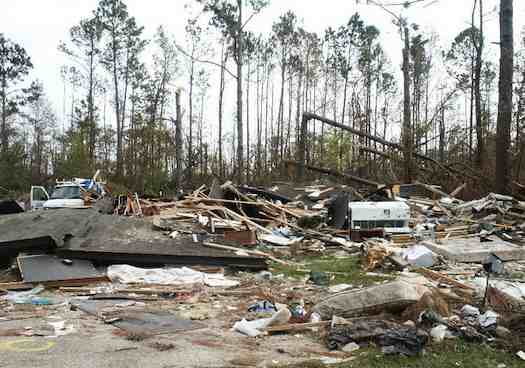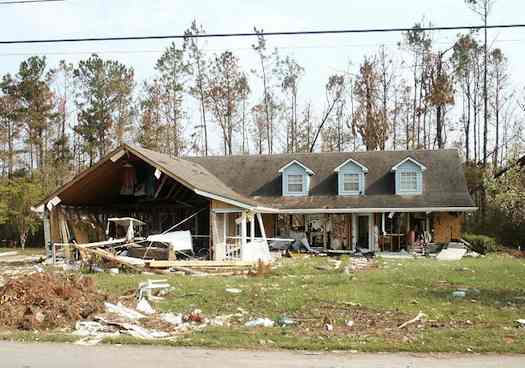Has it really been five years already? The memories are starting to fade but they come back to life in ghostly form on the anniversary of Hurricane Katrina, when the news media forces me to pay attention to them. Our family was one of the lucky ones. I can’t and won’t compare our story to those who fared much worse. My heart goes out to those who suffered through staggering hardships and still struggle to recover. I was even luckier personally, sitting safely away, 1,200 miles distant while various family members battled the storm’s wrath.
I decided I better write some of this down before I lose even more of the details. They are fading away rapidly with the passage of time.
I do have a few photographs to help me remember the events, and I’m going share some of them with you today. Family members took them in the days immediately following Katrina unless marked otherwise.
I’d been visiting family along the Mississippi Gulf Coast and in the suburbs of New Orleans, Louisiana just a few weeks before the storm. I go down there often and this trip seemed no different than any of the dozens of others I’d made over the years. Hurricanes are a fact of life along the coast. Why would this one be any different?
It Seemed So Normal Beforehand
This is where my wife and I went out to dinner one evening that summer. My mom was gracious enough to watch our son so we could get some quiet time alone. Katrina would wipe the Dock of the Bay restaurant from the face of the earth in short course. The current (August 2010) version of Google Street View for Bay St. Louis, Mississippi still provides a label for that nonexistent place along the bayfront, a phantom reminder of what once stood here. Go ahead and pop that map into a larger image and walk along Beach Boulevard towards the railroad bridge. You’ll see plenty of gutted shells and empty lots where a vibrant strand of homes, shops and restaurants stood until August 2005.
Then the Hurricane Hit

Most of my family fled from the area as warnings grew increasingly frantic. They scattered to the relative safety of Natchez, Houston and the Florida Panhandle. One of my sisters remained. It was a different storm along the Mississippi Gulf Coast, ferocious and intense with an immediate storm surge unlike the slow-motion misery that engulfed New Orleans. She didn’t realize, nobody realized, the surge would punch inland several miles along bayou conduits.
Flooded Home
She called my father as water poured through the doorway and rose towards the ceiling. Then she sought refuge along with her three children in an attic crawlspace above the garage, water still rising, and then the conversation ended. The local phone network succumbed to the winds. For the next 36 hours we considered them dead, dreading notification as next of kin.
We didn’t know until later that somehow they’d kicked a hole through the attic with their feet and climbed atop the roof. There they remained exposed to the elements for several hours as the hurricane eyewall and then the backside of the storm crossed above them, and twelve feet of torrential storm surge turned their precarious perch into an island.

They were safe once the storm passed and the surge dissipated. A local Southern Baptist congregation open its doors and provided refuge for many battered families that first night, where pews became makeshift beds. The house was unsalvageable and her car had to be junked after floating into a neighbor’s yard. They lost everything but the few items they could scavenge from their waterlogged home several days later, but they were alive.
Hanging On

My brother-in-law was a policeman in one of the most devastated communities along the Gulf Coast. The officers retreated to their station only a few hundred feet from the coastline, a solid bunker designed to withstand hurricane-force winds with ease. They understood the danger but they had a duty to aid the populace once the storm passed.
The building held firm and provided refuge until it disappeared under the storm surge. He and several other officers clung to a tree for their lives and somehow avoided being swept into the Gulf, their grips so tight that they stripped the bark under their hands. Today he is no longer a policeman, nor does he live anywhere near the Gulf Coast. I’d call that a rational choice given the circumstances.
Other Stories

The aunt of another brother-in-law rode out the storm from her bayfront home. She was not as lucky. She simply disappeared along with her house and everything she owned, never to be seen again. Gone. The only evidence remaining was a concrete slab where her home once stood.
Two of my nephews were caught on Interstate 10 trying to flee New Orleans in advance of the storm. They were stuck for hours but made it out in the nick of time. A few weeks later they got to experience it all over again when Hurricane Rita rolled through their temporary refuge in Houston, Texas.
Damage Still Remains
It doesn’t take much effort to find evidence of Hurricane Katrina even five years later. I confirmed that for myself when I was down there in April 2010. Remnants are beginning to fade though, along with the collective memory. This was the first visit where every conversation didn’t turn eventually to the simple phrase, “well, before Katrina…” It still came up but not continuously, similar to the found objects in the woods that are being pulled gradually back into the earth by undergrowth. Houses are beginning to spout on the exact foundations that were swept clean earlier. Let’s hope stricter building codes prevail when the inevitable returns.
My kids still call my mother Grandma Hurricane, much to her chagrin.

Leave a Reply